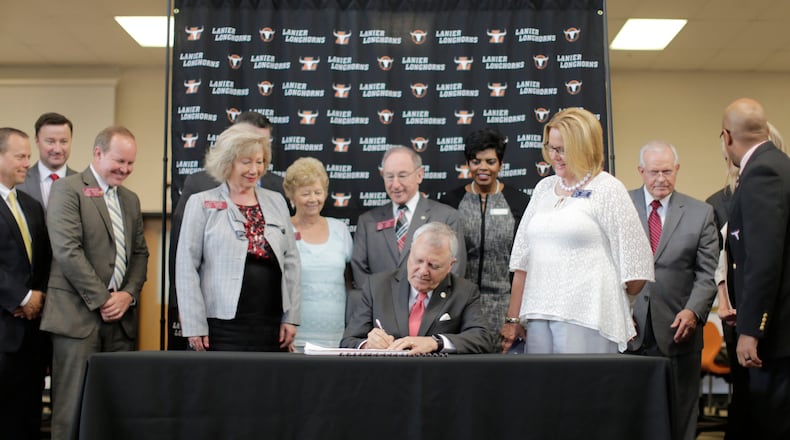Gov. Nathan Deal and lawmakers this year promised 200,000 teachers and state employees that they’d get 3 percent raises, their first substantial increase since before the Great Recession.
While most state employees were expected to get increases, a Georgia Department of Education survey found that only 40 percent of school districts passed along the money as a salary hike.
About 40 percent more used at least some of the money on a one-time bonus — not necessarily 3 percent — for fear they couldn’t afford to pay for the raise in the future if the state didn’t continue funding it.
Others used the extra raise money — about $300 million statewide — to reduce teacher furloughs left over from the recession or to fill holes in their school system budgets. Some districts, the Department of Education reported, are still having teachers take days off without pay to cut costs years after the recession ended.
Deal’s spokeswoman, Jen Talaber Ryan, said Monday that with all the extra state money flowing to school districts in recent years, furloughs should have been eliminated by now and teachers should have gotten raises. She said the governor will mandate that school systems give teachers the raises the state promises to provide in the future.
How school systems used the pay-raise money shows the clear split between urban and rural, have and have-not districts in Georgia. The Department of Education survey shows most urban districts gave pay raises, although not all the full 3 percent. Most who used it to cut furloughs or give one-time bonuses were districts from small-town Georgia.
“There are systems across the state, small systems, that are just struggling to pay the bills,” said Louis Fordham, a school board member in Whitfield County in far North Georgia.
Warren County Superintendent Carole Jean Carey said her district was able to eliminate teacher furloughs with the pay-raise money.
“When you are in a small, rural poverty area where the businesses have closed and the tax base is declining, and your enrollment is declining, there is no way to give those raises right now,” she said.
That is a problem Deal and lawmakers will try to tackle during the 2017 session that starts in January, when the governor wants to update the state’s formula for funding public schools.
John Palmer, an educator in Cobb County, said the 3 percent pay raise was an unkept promise for many teachers .
“I honestly think most teachers are just figuring out that this is just a political game,” he said.
House Appropriations Chairman Terry England, R-Auburn, said he was surprised that some districts chose to give one-time bonuses rather than raising the base pay of teachers.
“The message was pretty clear,” England said. “We told them we wanted you to use it for pay raises or eliminating furlough days.”
The mixed use of the money was due to the willingness of Deal and the General Assembly to give local school boards the flexibility to spend the money how they saw fit.
In decades past, governors made a big deal out of announcing cost-of-living pay raises for teachers. Some teachers also are eligible for separate longevity raises, but it’s the cost-of-living raises that typically get the attention of teachers and the public.
During the Great Recession, state officials deeply reduced school funding and stopped giving cost-of-living raises to teachers and state employees.
Once the state was able to fund raises again, England said local school board members and superintendents asked for the flexibility to use the money for pay increases or to eliminate furloughs and build up school calendars that had been cut back during the recession.
Lawmakers agreed. So when Deal and legislators began putting money into the budget again for raises, it didn’t necessarily mean the money would go for pay increases.
That happened despite the fact that during Deal's budget address to lawmakers in January 2016, he declared that the $300 million in extra state money was more than enough for 3 percent pay hikes.
“We will distribute this money to your local school system under the existing formula, but it is our intention that your local school system pass the 3 percent pay raise along,” he said. “If that does not happen, it will make it more difficult next year for the state to grant local systems more flexibility in the expenditure of state education dollars.”
On Monday, Ryan said: “Governor Deal has given local school systems large increases in funding for the past three years and given them the flexibility to decide how to spend it. These additional resources, totaling $894 million, were sent to local school systems to restore instructional days, eliminate teacher furloughs and increase teacher salaries.
“Last year, 94 percent of school systems reported eliminating furlough days. With the additional spending this year, furloughs should have been a thing of the past and teachers should have received that 3 percent pay raise,” she added. “Since so many did not, Governor Deal is left with no other option; silo the pay raise, which will mandate teachers receive it.”
Many districts who used the money to cut back on or eliminate furloughs say their teachers got raises because they no longer take as many days off without getting paid.
“Technically, we did give a raise,” said Randy Yeargin, a school board member in Oglethorpe County near Athens. “We forgave two of those furlough days with that (state money), and we forgave the other one with local money. We gave them more than 3 percent.”
Yeargin said districts such as his have been hit hard by increases in state health insurance for employees. The state shifted higher costs onto school districts to pay for health insurance for noncertified personnel, such as bus drivers. So-called "austerity cuts," left over from past recessions, still hit districts, although the Deal administration has pumped hundreds of millions of dollars more into the school funding formula to whittle those down.
Like other school officials The Atlanta Journal-Constitution talked to, Yeargin said there are concerns that if districts increase the base pay of teachers 3 percent this year, it becomes a permanent part of their budget, whether the state continues to fund it or not in the future.
“We would love to give a 3 percent raise,” he said, “but if we need to cut money out of the budget, we would have to add furloughs.”
Fordham’s Whitfield County schools had to use the raise money to help eliminate furloughs as well.
“The math is the math,” he said. “When you are not at a full school year, that’s a priority. And the so-called raise (money) gets you partway back. That’s great, but it doesn’t solve the problem. Our employees didn’t get hung up with where the money came from.”
Ross Hickman, a middle school teacher in Whitfield County, said getting the furloughs back wasn’t the same as getting a pay raise.
“We are working extra for the extra money, and we are only getting back to where we were in 2008,” he said. “It was demoralizing for the state to promise a 3 percent pay raise. There is a lot of anger misdirected at local school boards and local superintendents. The 3 percent raise should have been added to the (state) salary schedule.”
England, who has reviewed the Department of Education survey, said, “I was kind of surprised some districts still had furloughs.”
Only 10 districts in the state reported continuing furloughs during this school year, with Dougherty County being the only large urban system on the list.
Palmer, the Cobb educator and a spokesman for the teacher group TRAGIC, said he thinks lawmakers didn’t build the 3 percent raise money into the base salary for teachers because they wanted a lower state pay scale when they redraw the school funding formula.
“It’s a shell game,” he said. “They didn’t want to raise the base pay because it would skew the base higher when they change the formula. Most teachers understand that. We know if the governor wanted to give it to the teachers (as a 3 percent raise), he would have put it in the base pay.”
About the Author
Keep Reading
The Latest
Featured




